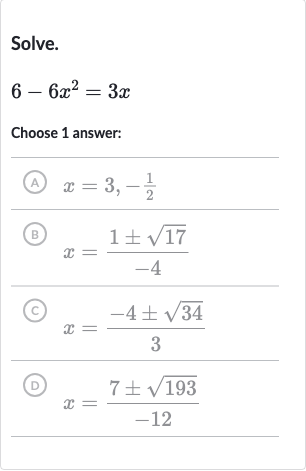AI tutor
Full solution
Q. Solve.Choose answer:(A) (B) (C) (D)
- Rearrange Equation: First, we need to rearrange the equation into the standard quadratic form .Move all terms to one side of the equation to get zero on the other side.Now, we have a quadratic equation in the form , where , , and .
- Quadratic Formula: Next, we will use the quadratic formula to find the solutions for . The quadratic formula is . Here, , , and .
- Calculate Discriminant: Now, we calculate the discriminant, which is the part under the square root in the quadratic formula: .Discriminant = Discriminant = Discriminant = Discriminant =
- Plug Values into Formula: With the discriminant calculated, we can now plug the values into the quadratic formula.
- Simplify Square Root: We simplify the square root of to get the exact solutions. is not a perfect square, so we leave it as is.
- Compare Solutions: Now we have two possible solutions for , which correspond to the in the formula. or These are the exact solutions in simplified radical form.
- Compare Solutions: Now we have two possible solutions for , which correspond to the "±" in the formula. or These are the exact solutions in simplified radical form.We can now compare our solutions to the answer choices given. - This does not match our solutions. - This does not match our solutions. - This does not match our solutions. - This does not match our solutions.Our solutions do not match any of the given answer choices exactly, which suggests there may be a mistake in the answer choices or in our calculations.
More problems from Solve a quadratic equation using the quadratic formula
QuestionGet tutor help
QuestionGet tutor help
QuestionGet tutor help
QuestionGet tutor help
QuestionGet tutor help
QuestionGet tutor help
QuestionGet tutor help
QuestionGet tutor help

